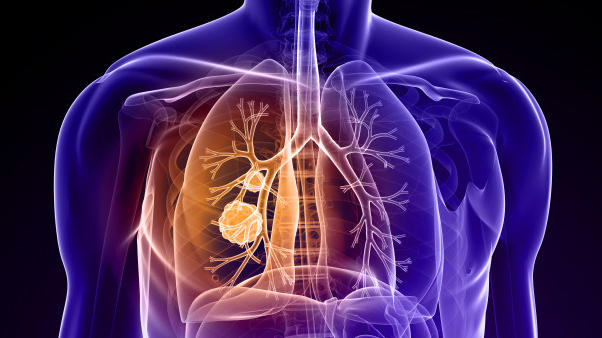
A diagnosis of lung cancer naturally causes some overwhelming emotions, but you don’t have to let those emotions get the best of you. Information is a powerful weapon against uncertainty and fear, and you can use this to your advantage. When you’re armed with plenty of accurate information, it’s much easier to make the educated decisions you need to make to achieve the best possible outcome with your treatment.
One of the first things you need to know before working with your doctor to develop a treatment plan for lung cancer is the stage — also known as the progression — of the disease. Learning about the stages of lung cancer can help you understand the terminology and how things like tumor size and tumor location — one lung, both lungs, other parts of the body — make a difference in your treatment approach.
In most cases, the chance of effective treatment is higher in the early stages versus the later stages of lung cancer, but it’s important to remember that every patient responds differently to the various treatments. Choosing the right treatment for your particular body and type of cancer will achieve the best results. Start by learning about the stages of lung cancer so you can fully understand your diagnosis.
Types of Lung Cancer
Lung cancer is actually a broad term for the two main types of lung cancer: small cell lung cancer and non-small cell lung cancer. As the names suggest, the appearance of the cancer cells is the key difference between the two forms of the disease. When viewed under a microscope, malignant cells in small cell lung cancer are round and smaller than malignant cells in non-small cell lung cancer.
In terms of symptoms, both types of lung cancer have many of the same effects on the human body, but small cell lung cancers tend to cause fatigue and weight loss and spread more rapidly. As a result, the staging criteria for the two types of cancer are different.
Stages of Non-Small Cell Lung Cancer
Non-small cell lung cancer is the most common type of lung cancer — accounting for about 80% to 85% of cases — and consists of several specific subtypes, including adenocarcinoma, squamous cell carcinoma and large cell carcinoma. Treatment plans and outcomes tend to be similar for the subtypes, which is why the broad non-small cell lung cancer classification is frequently used. For these types of lung cancer, the stage of the cancer helps your doctor determine the most effective treatment plan for your case.

The staging system for non-small cell lung cancer is much more extensive than small cell lung cancer. Doctors use the Tumor Node Metastasis (TNM) Staging System to determine the progression of a patient’s non-small cell lung cancer. This system evaluates the size of the original tumor and its location in the body, the node involvement (spread of the cancer to the lymph nodes), and possible metastasis (spread of the cancer to other organs in the body, such as the liver, bones or brain).
TNM Staging System for Non-Small Cell Lung Cancer
The TNM Staging System includes six primary stages: Occult, Stage 0, Stage I, Stage II, Stage III and Stage IV. Several of those stages break down into various sub-stages. In the Occult stage, cancer cells may appear in mucus, but the tumor is too small to detect in imaging diagnostics. Stage 0 consists of a very small tumor that hasn’t spread outside the lungs or deep into the lung tissue. Stage I involves a tumor deeper in the lungs, but it hasn’t spread to the nearby lymph nodes. Tumor size ranges from 1 cm to 4 cm. All of these stages are often highly treatable.
In Stage II, the cancer has spread to nearby lymph nodes or the chest wall. Tumor size ranges from 3 cm to 7 cm. By Stage III, the cancer is in the lung, possibly in more than one lobe, and has spread to the lymph nodes and the middle of the chest. Tumor size ranges from 3 cm to more than 7 cm. Stage IIIA specifically designates cancer in the lymph nodes on the same side of the chest where the tumor originally formed, while Stage IIIB designates cancer in the lymph nodes on the opposite side of the chest or in the lymph nodes near the collarbone.
In Stage IV, cancer is present in both lungs as well as the area around the lungs and has spread to other organs. This is the most advanced stage of lung cancer. By the time the cancer reaches Stage IV, it has often spread to the brain, bones or liver and is difficult to treat. Fluid containing cancer cells may also form around the lungs and heart at this stage.
Stages of Small Cell Lung Cancer
Small cell lung cancer makes up about 10% to 15% of all lung cancer cases and is most often caused by smoking. Most doctors use the results of biopsies and imaging tests to divide this type of lung cancer into two stages: limited and extensive. In the limited stage, the cancer is only in one lung but may have spread to nearby lymph nodes. In the extensive stage, the cancer has spread to both lungs, and there is fluid around the lungs or around other organs in the body.

The TNM Staging System is also valid and occasionally used to stage small cell lung cancer cases, but this is less common. Most doctors pay less attention to the TNM method for this type of lung cancer.
All lung cancers respond better to chemotherapy and other treatments when they are diagnosed in the early stages. However, the stage of cancer isn’t a perfect indicator of the effectiveness of treatment or the expected lifespan of the patient. As with most diseases, the outcome can vary a great deal from case to case.
Resource Links:
https://www.cancer.org/cancer/lung-cancer/about/what-is.html
https://www.cancer.org/cancer/lung-cancer/causes-risks-prevention/risk-factors.html
https://www.cancer.org/cancer/lung-cancer/detection-diagnosis-staging/staging-sclc.html
https://www.cancer.org/cancer/lung-cancer/detection-diagnosis-staging/staging-nsclc.html





